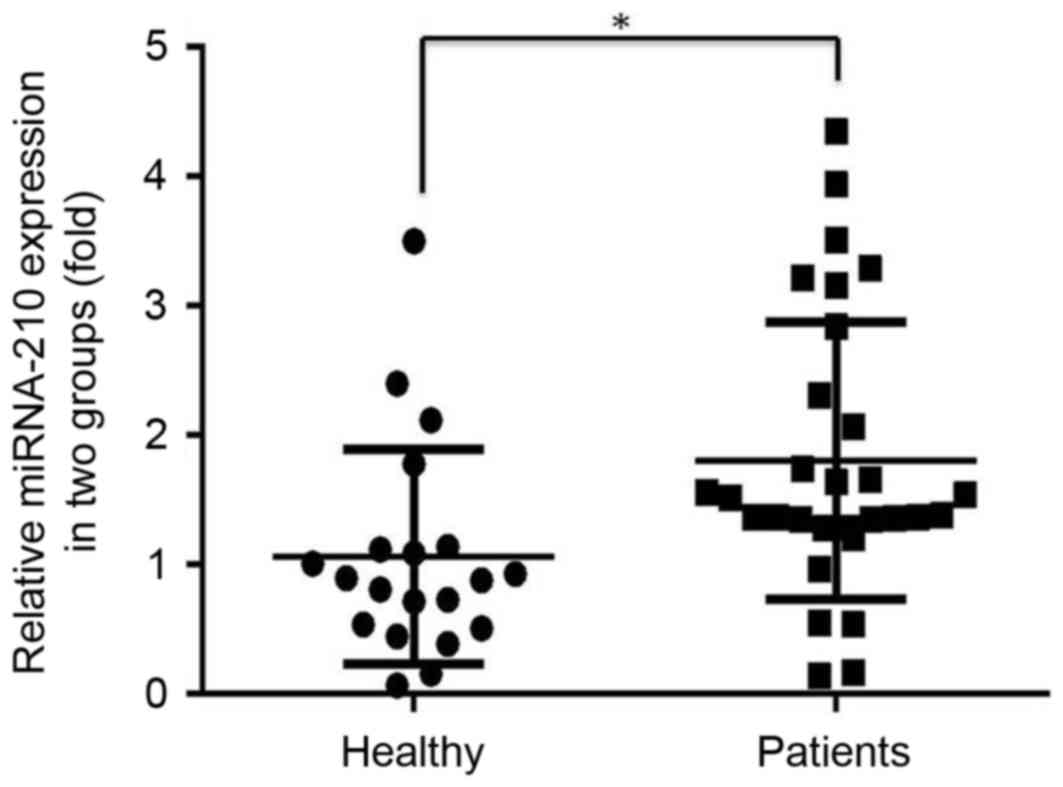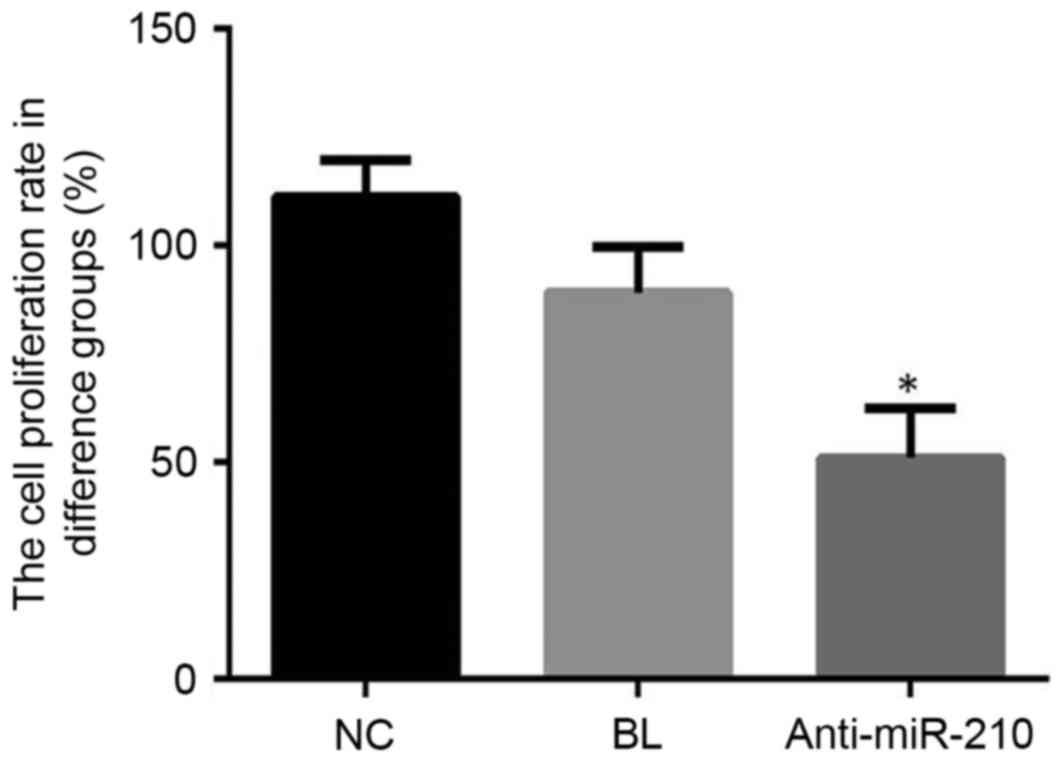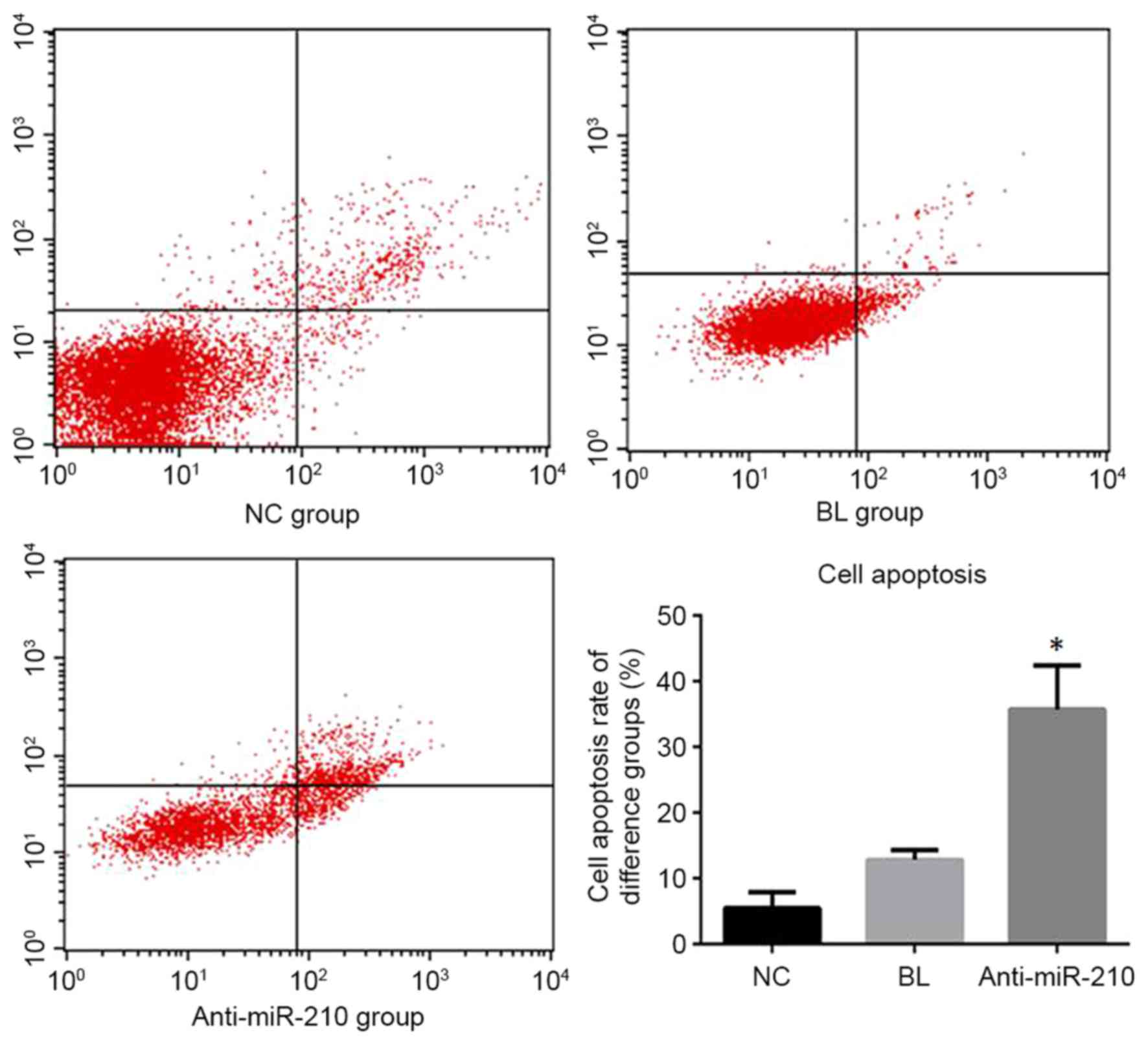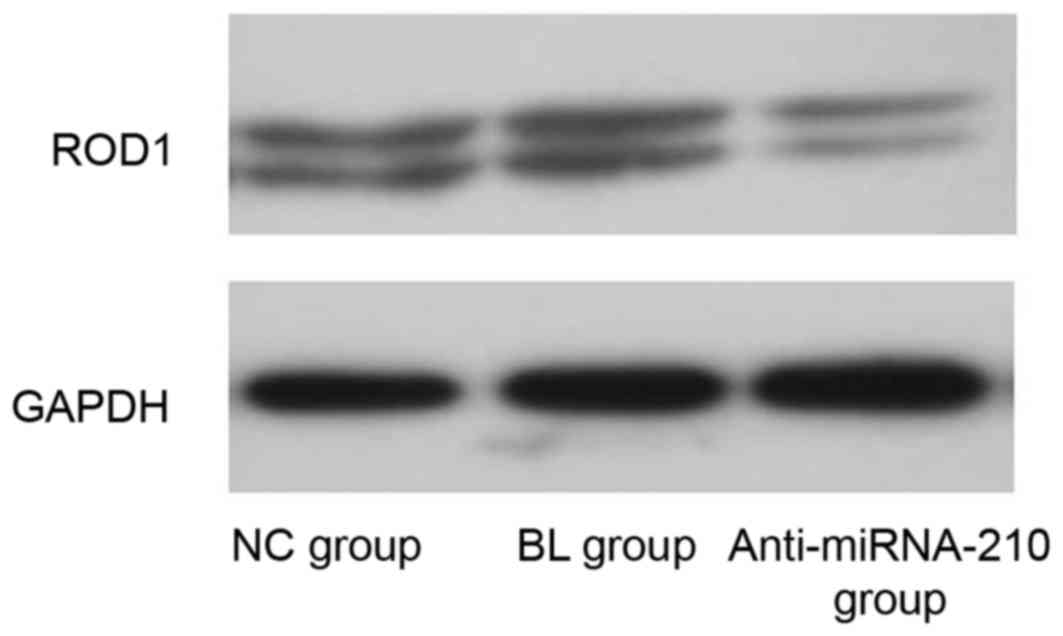Effects of microRNA‑210 on the diagnosis and treatment of prostate cancer
- Authors:
- Published online on: May 31, 2018 https://doi.org/10.3892/mmr.2018.9105
- Pages: 1740-1744
Abstract
Introduction
Prostate cancer (PCa) is the second most common cancer among men worldwide (1). Numerous factors are contribute to development of PCa, including genetic mutations and the tumor microenvironment (2,3). Therefore, understanding of the oncogenic pathologies in the progression of PCa may contribute to improved clinical diagnosis and treatment.
MicroRNAs (miRNA) are endogenous, non-coding short chain RNAs, which alter gene expression at the post-transcriptional level affecting angiogenesis, cell cycle, apoptosis, invasion and migration of the cells and tumor-associated gene expression, thereby affecting the tumor proliferation, invasion and metastasis (4–6). Several studies have suggested that miRNAs have been associated with PCa tumorigenesis and the clinical outcome of patients (7–9). Previous studies confirmed that microRNA-210 (miR-210) in renal cell carcinoma, pancreatic cancer, colorectal cancer, and regulation of cancer cell proliferation, migration and invasion in renal cell carcinoma (10–14). Additionally, the present study investigated its function in the regulation of proliferation and apoptosis and determined that the regulator of differentiation 1 (ROD1), a protein also termed polypyrimidine trace binding protein 3 (PTBP3), is a potential the target of miR-210 in cancer cells (15). However, to the best of our knowledge there is limited investigation of the correlation between miR-210 and prostate cancer has been relatively limited.
In this study, we had detected the difference of serum miR-210 expression between health and prostate cancer patients at first, and further study the effect of miR-210 on prostate cancer cells.
Materials and methods
Patients
A total of 30 prostate cancer patients that were treated between June 2013 to May 2015 were selected for the prostate cancer (PCa) group and 20 healthy people (all male; age range, 47–83 years; median age, 58 years), which underwent physical examination in our hospital at the same period were selected for the healthy control group. Venous blood was collected from healthy people and patients with PCa and serum was isolated immediately using centrifugation in serum-gel tubes at 3,500 × g for 10 min at 4°C and stored at −80°C, until further experiments were performed.
Cell line culture
The cells which have been collected from the PCa patients and used for primary cell culture. The RPMI 1640 medium containing 10% fetal bovine serum was used to culture the cells at 37°C and 5% CO2.
Materials
RPMI 1640 culture medium was purchased Gibco; Thermo Fisher Scientific, Inc. (Waltham, MA, USA), fetal bovine serum was purchased from ExCell Bio, Inc. (Shanghai, China), TRIzol Reagent, PrimeScript RT Master Mix reagent kit and SYBR Premix Ex Taq kit were purchased from Takara Bio, Inc. (Otsu, Japan), The miR-210 primer was constructed by the Shanghai GenePharma Co., Ltd. (Shanghai, China), Opti-MEM medium and Lipofectamine™ 2000 were purchased from Invitrogen; Thermo Fisher Scientific, Inc., the miR-210 inhibitor was synthesized by the Invitrogen; Thermo Fisher Scientific, Inc. (cat. no. 4464084), MTT was purchased from Amresco LLC (Solon, OH, USA), fluorescence quantitative PCR instrument purchased from ABI-7500 system employing Primix Ex Taq II SYBR kit, the centrifuge was purchased from Sigma-Aldrich; EMD Millipore (Billerica, MA, USA) and the flow cytometer was purchased from BD Biosciences (Franklin Lakes, NJ, USA).
Reverse transcription-quantitative polymerase chain reaction (RT-qPCR)
Total RNA was extracted from the serum of healthy and PCa groups and reverse transcribed to cDNA at 42°C for 60 min and 70°C for 5 min. The following primer sequences were used: miR-210 forward (F), 5′-CTGTGCGTGTGACAGCGGCTGA-3′, reverse (R) primers for universal primer real-time PCR Uni-miR primers (Takara Bio, Inc.); ROD1 F, 5′-AAGGAAATGAATGGGCAGCCGTTAG-3′ and R, 5′CATG-TAGTTGAGGTCAATGAAGGGGTC-3; GAPDH F, 5′-GCTCTCTGCTCCTCCTGTTC-3′ and R, 5′-GACTCCGACCTTCACCTTCC-3′. GAPDH was used as the internal control, qPCR was performed according to the manufacturer's instructions of the Primix Ex Taq II SYBR kit. Each sample was analyzed in triplicate. The following thermocycling conditions were used: 95°C for 30 sec, 95°C for 5 sec, 60°C for 31 sec and for 40 cycles. The 2−∆∆Cq method (16) was used to calculate the expression levels of miR-210 and ROD1.
Transfection
The transfection was performed according to the manufacturer's protocol using Lipofectamine™ 2000 for a 96-well (1×104 cells/per well) transfection. A total of 48 h following transfection, cells divided into the following treatment groups: i) NC group, untreated; ii) BL group, empty vector; and iii) anti-miR-210 group, miR-210 inhibitor-transfected.
Cell apoptosis detection
Apoptosis of cells was detected using Annexin V-fluorescein isothiocyanate/propidium iodide (Nanjing Keygen Biotech, Nanjing, China) double staining kit. Following transfection for 48 h, 1.0×105 cells/well, washed with PBS, 50 µl Annexin buffer, 5 µl 7-aminoactinomycin D, 5 µl Annexin V-phycoerythrin dye were added, following a reaction of 15 min, 200 µl buffer was added to detect apoptosis by flow cytometry using the BD FACSuite™ software (version 1.0; BD Biosciences). The experiment was repeated four times.
Western blot analysis
Cells were lysed in cold radioimmunoprecipitationlysis buffer (Thermo Fisher Scientific, Inc.). Protein concentration was measured using a bicinchoninic acid protein assay kit. Proteins (30 µg per lane) were separated on 10% SDS-PAGE and subsequently transferred to nitrocellulose membranes and then incubated with 5% skimmed milk for 2 h at room temperature. Subsequently, the membranes were probed with antibodies specific to ROD1 (cat. no. WH0009991M1; 1:200; Sigma-Aldrich; Merck Millipore) and GAPDH (cat. no. G8795; 1:1,000; Sigma-Aldrich; Merck Millipore) overnight at 4°C. Membranes were then incubated with anti-mouse horseradish peroxidase-conjugated secondary antibodies for 1 h at room temperature (cat. no. A9044; 1:5,000; Sigma-Aldrich; Merck KGaA). The membranes were washed three times in PBS and analyzed using enhanced chemiluminesence film system (GE Healthcare, Chicago, IL, USA).
Statistical analysis
Analysis was performed using SPSS version 19.0 (IBM Corporation, Armonk, NY, USA). Data were expressed as the mean ± standard deviation. One-way analysis of variance followed by a least significant difference post hoc test were used to identify statistical differences groups. P<0.05 was considered to indicate a statistically significant difference.
Results
Expression levels of miR-210 in healthy individuals and patients with PCa
The expression level of miR-210 in the serum of prostate cancer patients was significantly higher compared with that in healthy individuals (P<0.05; Fig. 1).
Cell proliferation
Cell proliferation in the anti-miR-210 group was significantly lower when compared with the NC group (P<0.05; Fig. 2). These findings suggested that a miR-210 inhibitor may effectively inhibit the proliferation of primary PCa cells.
Cell apoptosis detection
The anti-miR-210 group exhibited an apoptotic rate of 35.75+6.71%, which was significantly higher than the NC group 5.48+2.47% and BL group 12.83+1.47% (P<0.05; Fig. 3).
ROD1 mRNA and protein expression level
The expression level of miR-210 and ROD1 in the anti-miR-210 group was significantly reduced when compared with the NC and BL groups (P<0.05; Fig. 4). The expression level of ROD1 protein in the anti-miR-210 group was reduced compared with the NC group (Fig. 5).
Discussion
PCa is a common malignant tumor in men (1). It is the second most common malignant tumor in the United States. Additionally, it is the sixth most common mortality due to cancer (17). Recently, the incidence and mortality of PCa in China has significantly increased and is gradually approaching that of European and American countries, and has become a serious threat to the health of the elderly men (18). Molecular-targeted therapy is a novel therapeutic method, developed in recent years (19). It has become an important area of research for effective therapeutic targets, and miR-210 appears to provide a new target for the diagnosis and treatment of prostate cancer (20). A previous study revealed that more than half of the miRNAs are located in the region of tumor-associated genes and fragile sites, loss of heterozygosity, amplification area or fault zone, suggesting that miRNAs may be used as oncogenes or tumor suppressor genes (21). At present, miRNAs may regulate gene expression at the post-transcriptional level, which is primarily used as a negative regulator of gene expression. A previous study confirmed that miRNA affected angiogenesis, cell cycle, apoptosis, cell invasion and migration (19). A previous study confirmed that many tumors, including prostate cancer, have many miRNA expression abnormalities, and have a different role in different stages of tumor cell migration, invasion and angiogenesis (20).
Volinia et al determined that miR-20a was overexpressed in prostate cancer tissues by using miRNA microarrays (22). Sylvestre et al identified that after transfection of an miR-20a inhibitor into PCa cells, the apoptotic rate was significantly increased, which indicated that miR-20a had an anti-apoptotic role in PCa cells (23). Previous studies have confirmed that expression level of miR-210 is increased in a number of solid tumors; however, no uniform trend has been identified, to the best of our knowledge (24–29).
The present study detected the expression of miR-210 in the serum of patients with PCa and healthy individuals. The current findings revealed that miR-210 in the serum of patients with PCa was overexpressed. In order to further clarify the role of mir-210 in PCa, an miR-210 antagonist transfection was used in primary PCa cells. The present findings revealed that the anti-miR-210 group cell proliferation rate was significantly reduced compared with that of the NC and BL groups, and the apoptotic was significantly greater. In order to determine the mechanism of action of miR-210 in prostate cancer, the expression levels of the associated genes and proteins were also determined.
ROD1, a protein also termed PTBP3, is the potential target of miRNA-210 in various types of cancer, including glioblastoma multiforme (30,31). The present study determined that the ROD1 mRNA and protein expression levels in the anti-miR-210 group were significantly reduced and it may be possible that miR-210 inhibitors reduced cell proliferation and increased apoptotic rate of PCa cells by inhibiting ROD1 expression level.
In summary, the present study demonstrated that miR-210 was overexpressed in patients with PCa and that miR-210 may function as an oncogene. Based on the present study, it is possible that miR-210 may be a novel biomarker for prostatic cancer, and it may regulate tumor progression through by targeting ROD1. As PCa is a form of cancer that progresses and spreads quickly, traditional therapies, such as surgery and chemo and radiotherapy have only limited effectiveness in treating this aggressive disease. Therefore, novel approaches, such as molecular targeting would be beneficial in the therapeutic treatment of PCa. Targeting miR-210 may provide a novel therapeutic option in the treatment of this disease. In conclusion, miR-210 may have a key role in PCa diagnosis and treatment by regulating ROD1 miRNA and protein expression levels.
Acknowledgements
Not applicable.
Funding
No funding was received.
Availability of data and materials
The analyzed data sets generated during the study are available from the corresponding author on reasonable request.
Authors' contributions
YQ and WH contributed to study design, data collection, data interpretation, preparation of manuscript and literature analysis.
Ethics approval and consent to participate
The present study was approved by the Human Ethics Committee Review Board at the Medical Group of Ping Mei Shenma General Hospital. All participants signed written informed consent forms.
Consent for publication
Not applicable.
Competing interests
The authors declare that they have no competing interests.
References
|
Siegel RL, Miller KD and Jemal A: Cancer statistics 2016. CA Cancer J Clin. 66:7–30. 2016. View Article : Google Scholar : PubMed/NCBI | |
|
Santanam U, Banach-Petrosky W, Abate-Shen C, Shen MM, White E and DiPaola RS: Atg7 cooperates with Pten loss to drive prostate cancer tumor growth. Genes Dev. 30:399–407. 2016. View Article : Google Scholar : PubMed/NCBI | |
|
Miftakhova R, Hedblom A, Semenas J, Robinson B, Simoulis A, Malm J, Rizvanov A, Heery DM, Mongan NP, Maitland NJ, et al: Cyclin A1 and P450 aromatase promote metastatic homing and growth of stem-like prostate cancer cells in the bone marrow. Cancer Res. 76:2453–2464. 2016. View Article : Google Scholar : PubMed/NCBI | |
|
Negrini M and Calin GA: Breast cancer metastasis: A microRNA story. Breast Cancer Res. 10:2032008. View Article : Google Scholar : PubMed/NCBI | |
|
Redova M, Poprach A, Besse A, Iliev R, Nekvindova J, Lakomy R, Radova L, Svoboda M, Dolezel J, Vyzula R and Slaby O: MiR-210 expression in tumor tissue and in vitro effects of its silencing in renal cell carcinoma. Tumour Biol. 34:481–491. 2013. View Article : Google Scholar : PubMed/NCBI | |
|
Bakirzi K, Law IK, Xue X, Iliopoulos D, Shah YM and Pothoulakis C: Neurotensin promotes the development of colitis and intestiinal angiogenesis via Hif-1α-miR-210 signaling. J Immunol. 196:4311–4321. 2016. View Article : Google Scholar : PubMed/NCBI | |
|
Rane JK, Scaravilli M, Ylipää A, Pellacani D, Mann VM, Simms MS, Nykter M, Collins AT, Visakorpi T and Maitland NJ: MicroRNA expression profile of primary prostate cancer stem cells as a source of biomarkers and therapeutic targets. Eur Urol. 67:7–10. 2015. View Article : Google Scholar : PubMed/NCBI | |
|
Alhasan AH, Scott AW, Wu JJ, Feng G, Meeks JJ, Thaxton CS and Mirkin CA: Circulating microRNA signature for the diagnosis of very high-risk prostate cancer. Proc Natl Acad Sci USA. 113:10655–10660. 2016. View Article : Google Scholar : PubMed/NCBI | |
|
Li X, Wan X, Chen H, Yang S, Liu Y, Mo W, Meng D, Du W, Huang Y, Wu H, et al: Identification of miR-133b and RB1CC1 as independent predictors for biochemical recurrence and potential therapeutic targets for prostate cancer. Clin Cancer Res. 20:2312–2325. 2014. View Article : Google Scholar : PubMed/NCBI | |
|
Toyama T, Kondo N, Endo Y, Sugiura H, Yoshimoto N, Iwasa M, Takahashi S, Fujii Y and Yamashita H: High expression of microRNA-210 is an independent factor indicating a poor prognosis in Japanese triple-negative breast cancer patients. Jpn J Clin Oncol. 42:256–263. 2012. View Article : Google Scholar : PubMed/NCBI | |
|
Eilertsen M, Andersen S, Al-Saad S, Richardsen E, Stenvold H, Hald SM, Al-Shibli K, Donnem T, Busund LT and Bremnes RM: Positive prognostic impact of miR-210 in non-small cell lung cancer. Lung Cancer. 83:272–278. 2014. View Article : Google Scholar : PubMed/NCBI | |
|
Neal CS, Michael MZ, Rawlings LH, Van der Hoek MB and Gleadle JM: The VHL-dependent regulation of microRNAs in renal cancer. BMC Med. 8:642010. View Article : Google Scholar : PubMed/NCBI | |
|
Lai NS, Dong QS, Ding H, Miao ZL and Lin YC: MicroRNA-210 overexpression predicts poorer prognosis in glioma patients. J Clin Neurosci. 21:755–760. 2014. View Article : Google Scholar : PubMed/NCBI | |
|
Cai H, Lin L, Cai H, Tang M and Wang Z: Prognostic evaluation of microRNA-210 expression in pediatric osteosarcoma. Med Oncol. 30:4992013.Andersen S, Richardsen E, Moi L, Donnem T, Nordby Y, Ness N, Holman ME, Bremnes RM and Busund LT: Fibroblast miR-210 overexpression is independently associated with clinical failure in prostate cancer-a multicenter (in situ hybridization) study. Sci Rep 6: 36573, 2016. View Article : Google Scholar : PubMed/NCBI | |
|
Livak KJ and Schmittgen TD: Analysis of relative gene expression data using real-time quantitative PCR and the 2(-Delta Delta C(T)) method. Methods. 25:402–408. 2001. View Article : Google Scholar : PubMed/NCBI | |
|
Bray F and Soerjomataram I: The changing global burden of cancer: Transitions in human development and implications for cancer prevention and controlCancer: Disease Control Priorities. Gelband H, Jha P, Sankaranarayanan R and Horton S: 3. 3rd edition. The International Bank for Reconstruction and Development/The World Bank; Washington, DC: 2015 | |
|
Zhang K, Bangma CH and Roobol MJ: Prostate cancer screening in Europe and Asia. Asian J Urol. 4:86–95. 2017. View Article : Google Scholar : PubMed/NCBI | |
|
Riquelme I, Saavedra K, Espinoza JA, Weber H, García P, Nervi B, Garrido M, Corvalán AH, Roa JC and Bizama C: Molecular classification of gastric cancer: Towards a pathway-driven targeted therapy. Oncotarget. 6:24750–24779. 2015. View Article : Google Scholar : PubMed/NCBI | |
|
Taylor DD and Gecel-Taylor C: MicroRNA signatures of tumor-derived exosomes as diagnostic biomarkers of ovarian cancer. Gynecol Oncol. 110:13–21. 2008. View Article : Google Scholar : PubMed/NCBI | |
|
Chen X, Ba Y, Ma L, Cai X, Yin Y, Wang K, Guo J, Zhang Y, Chen J, Guo X, et al: Characterization of microRNAs in serum: A novel class of biomarkers for diagnosis of cancer and other diseases. Cell Res. 18:997–1006. 2008. View Article : Google Scholar : PubMed/NCBI | |
|
Dumont N and Tlsty TD: Reflections on miR-ing effects in metastais. Cancer Cell. 16:3–4. 2009. View Article : Google Scholar : PubMed/NCBI | |
|
Volinia S, Calin GA, Liu CG, Ambs S, Cimmino A, Petrocca F, Visone R, Iorio M, Roldo C, Ferracin M, et al: A microRNA expression signature of human solid tumors defines cancer gene targets. Proc Natl Acad Sci USA. 103:2257–2261. 2006. View Article : Google Scholar : PubMed/NCBI | |
|
Sylvestre Y, De Guire V, Querido E, Mukhopadhyay UK, Bourdeau V, Major F, Ferbeyre G and Chartrand P: An E2F/miR-20a autoregulatory feedback loop. J Biol Chem. 282:2135–2143. 2007. View Article : Google Scholar : PubMed/NCBI | |
|
McCormick R, Buffa FM, Ragoussis J and Harris AL: The role of hypoxia regulated microRNAs in cancer. Curr Top Microbiol Immunol. 345:47–70. 2010.PubMed/NCBI | |
|
Tsuchiya S, Fujiwara T, Sato F, Shimada Y, Tanaka E, Sakai Y, Shimizu K and Tsujimoto G: MicroRNA-210 regulates cancer cell proliferation through targeting fibroblast growth factor receptor-like 1 (FGFRL1). J Biol Chem. 286:420–428. 2011. View Article : Google Scholar : PubMed/NCBI | |
|
White NM, Bao TT, Grigull J, Youssef YM, Girgis A, Diamandis M, Fatoohi E, Metias M, Honey RJ, Stewart R, et al: miRNA profiling for clear cell renal cell carcinoma: Biomarker discovery and identification of potential controls and consequences of miRNA dysregulation. J Urol. 186:1077–1083. 2011. View Article : Google Scholar : PubMed/NCBI | |
|
Zhao A, Li G, Péoc'h M, Genin C and Gigante M: Serum miR-210 as a biomarker for molecular diagnosis of clear cell renal cell carcinoma. Exp Mol Pathol. 94:115–120. 2013. View Article : Google Scholar : PubMed/NCBI | |
|
Shen J, Liu Z, Todd NW, Zhang H, Liao J, Yu L, Guarnera MA, Li R, Cai L, Zhan M and Jiang F: Diagnosis of lung cancer in individuals with solitary pulmonary nodules by plasma microRNA biomarkers. BMC Cancer. 11:3742011. View Article : Google Scholar : PubMed/NCBI | |
|
Ho AS, Huang X, Cao H, Christman-Skieller C, Bennewith K, Le QT and Koong AC: Circulating miR-210 as a novel hypoxia marker in pancreatic cancer. Transl Oncol. 3:109–113. 2010. View Article : Google Scholar : PubMed/NCBI | |
|
Zhang S, Lai N, Liao K, Sun J and Lin Y: MicroRNA-210 regulates cell proliferation and apoptosis by targeting regulator of differentiation 1 in glioblastoma cells. Folia Neuropathol. 53:236–244. 2015. View Article : Google Scholar : PubMed/NCBI | |
|
Fasanaro P, Romani S, Voellenkie C, Maimone B, Capogrossi MC and Martelli F: ROD1 is a seedless target gene of hypoxia-induced miR-210. PLoS One. 7:e446512012. View Article : Google Scholar : PubMed/NCBI |















